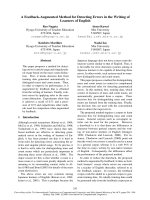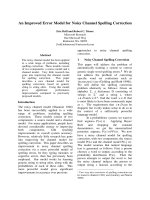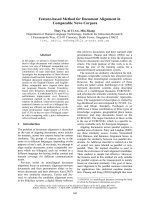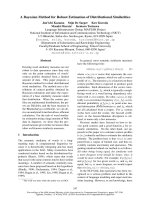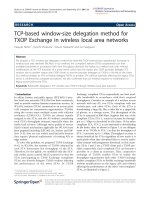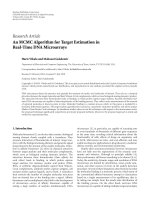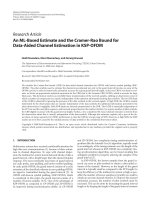AN IMPROVED INTERPOLATION METHOD FOR CHANNEL ESTIMATION IN AN ORTHOGONAL FREQUENCY DIVISION MULTIPLEXING (OFDM) SYSTEM USING PILOT SIGNALS
Bạn đang xem bản rút gọn của tài liệu. Xem và tải ngay bản đầy đủ của tài liệu tại đây (5.8 MB, 153 trang )
AN IMPROVED INTERPOLATION METHOD FOR CHANNEL ESTIMATION IN
AN ORTHOGONAL FREQUENCY DIVISION MULTIPLEXING (OFDM)
SYSTEM USING PILOT SIGNALS
AHMED NOORI HUMMADI
THESIS SUBMITTED IN FULFILMENT FOR THE DEGREE OF
DOCTOR OF PHILOSOPHY
FACULTY OF ENGINEERING AND BUILT ENVIRONMENT
UNIVERSITI KEBANGSAAN MALAYSIA
BANGI
2011
KAEDAH INTERPOLASI DIPERBAIKI BAGI PENGANGGARAN SALURAN
DALAM SISTEM PEMULTIPLEKSAN PEMBAHAGIAN FREKUENSI
ORTOGON MENGGUNAKAN ISYARAT PEMANDU
AHMED NOORI HUMMADI
TESIS YANG DIKEMUKAKAN UNTUK MEMPEROLEH IJAZAH
DOKTOR FALSAFAH
FAKULTI KEJURUTERAAN DAN ALAM BINA
UNIVERSITI KEBANGSAAN MALAYSIA
BANGI
2011
ii
DECLARATION
I hereby declare that the work in this thesis is my own except for quotations and
summaries which have been duly acknowledged.
Date
5/10/2011
AHMED NOORI HUMMADI
P43836
iii
AKNOWLEDGMENTS
Praise is to Allah Almighty for giving me the strength, patience and ability to
complete this thesis.
I would like to thank my supervisor Professor Dr. Mahamod Ismail for his
thoughtful comments, guidance, attention and encouragement. Thank you for the
invaluable advice and assistance. My Thanks go to my co-supervisor Professor Dr.
Mohd Alauddin Mohd Ali for her support and help.
My beloved family for all support, patience, understanding and being helpful
throughout my study. I give my deepest gratitude and sincerest love to my parents for
their love and support through my entire life. Special thank to my brother Muneer for
his help to solve any problem floating on the surface with my employer.
I am grateful to all my colleagues, friends, staff, and lecturers in Faculty of
Engineering and Built Environment, Universiti Kebangsaan Malaysia and
Hadhramout University of Science and Technology for their help and support at every
step during this study.
I wish to extend my grateful appreciation to all those who have contributed
directly and indirectly to the preparation of this study. I would like to thank my best
friend Mona Alsayigh for her assistance. Not forgetting also, my examiners and all
committee members for their helpful suggestions.
iv
ABSTRACT
Orthogonal Frequency Division Multiplexing (OFDM) system can achieve high data
rates in mobile environment due to its robustness against the Inter Symbol
Interference (ISI). Likewise, development of efficient receiver with proper channel
estimation technique is crucial to ease the prediction of the received signal. Pilot
symbol assisted modulation introduced to achieve reliable channel estimation through
transmitting pilot signals along with in OFDM symbol. Moreover, interpolation
method developed to estimate the channel samples and eliminates the effect of the
fading channel from the received signals. However, most of the interpolation
techniques such as Linear, Cubic and Spline Cubic interpolation are irresistible against
the noise while the conventional interpolation is not resilience. The objective of this
work is to propose a new improved interpolation technique which is more reliable and
efficient for channel estimation in OFDM system based on pilot signal under fast
varying and noisy channels. The proposed interpolation is much simpler than other
technique, such as Linear, Second Order Modulation, Spline, Time domain, and Lowpass interpolation; where it depends on two parameters which are the mean and
variance of two adjacent pilot signals. Furthermore, this type of interpolation can be
modified to give more accurate estimation for the channel depending on two
modification factors (β and ξ). The mathematical formulations have been derived
based on linear interpolation technique and then validated using simulations. The
Mean Square Error (MSE) performance of the interpolation technique is then
compared with other five types of interpolation under Rayleigh fading channel using
comb type channel estimation. Simulations show that the proposed interpolation
technique able to estimate the channel much better than other interpolation types for
Signal to Noise Ratio (SNR) from 1 dB to 8 dB at MSE equal to 10-3 and as a result it
is much robust against noise which reduces the accuracy of the estimated channel.
Furthermore, the channel estimation is then used to examine the effect of pilot
estimation using different technique of estimation such as Least Square Error (LSE),
Minimum Mean Square Error (MMSE) and Wavelet De-noising. It is shown that pilot
estimation give superior MSE performance in channel estimation by about 20 dB at
low SNR. Simulation also shows that SNR performance improved up to 10 dB
comparing to other type of interpolation at BER equal to 10-3. Finally, the proposed
method also performed well in the estimation of the channel over different Doppler
frequencies and achieves higher OFDM system performances.
v
ABSTRAK
Sistem Pemultipleksan Pembahagian Frekuensi Ortogon (OFDM) dapat mencapai
kadar data yang tinggi dalam persekitaran bergerak kerana ketahanannya terhadap
Gangguan Antara Simbol (ISI). pembangunan penerima cekap dengan teknik
penganggaran saluran yang tepat sangat penting untuk memudahkan ramalan isyarat
yang diterima. Pemodulatan terbantu simbol pandu diperkenalkan untuk mencapai
penganggaran saluran yang bolehharap melalui penghantaran isyarat pandu bersamasama dengan simbol OFDM. Selain itu, kaedah interpolasi dibangunkan untuk
menganggarkan sampel saluran dan menghapuskan kesan pemudaran saluran daripada
isyarat yang diterima. Namun, sebahagian besar teknik interpolasi seperti interpolasi
Lelurus, Kubik dan Kubik Spline tidak berupaya menahan kesan hingar sementara
interpolasi konvensional tidak terkawal dan tidak anjal. Tujuan penyelidikan ini
adalah untuk mencadangkan suatu teknik interpolasi baru dipertingkatkan yang lebih
bolehharap dan cekap untuk penganggaran saluran dalam sistem OFDM berdasarkan
isyarat pandu dalam saluran berubah pantas dan berhingar. Interpolasi yang
dicadangkan adalah jauh lebih ringkas dari teknik yang lain, seperti interpolasi
Lelurus, Pemodulatan Tertib Kedua, Spline, domain Masa, dan Lulus rendah, yang
bergantung pada dua parameter iaitu min dan varians dari dua isyarat pandu yang
bersebelahan. Selanjutnya, jenis interpolasi ini boleh diubahsuai untuk memberikan
penganggaran yang lebih tepat untuk saluran bergantung pada dua faktor
pengubahsuaian (β dan ξ). Formulasi matematik telah diterbitkan berdasarkan teknik
interpolasi lelurus dan kemudian disahkan menggunakan simulasi. Prestasi Ralat
Ganda Dua Min (MSE) dari teknik interpolasi ini kemudian dibandingkan dengan
lima jenis interpolasi yang lain dalam saluran pemudaran Rayleigh menggunakan
penganggaran saluran jenis sikat. Simulasi menunjukkan bahawa teknik interpolasi
yang dicadangkan berupaya menganggarkan saluran jauh lebih baik berbanding jenis
interpolasi yang lain untuk Nisbah Isyarat Terhadap Hingar (SNR) dari 1 dB hingga 8
dB pada MSE sebanyak 10-3 dan sebagai hasilnya teknik ini jauh lebih tahan terhadap
hingar yang mengurangkan kejituan saluran dijangka. Selanjutnya, penganggaran
saluran ini kemudian digunakan untuk menguji kesan penganggaran pandu
menggunakan teknik penganggaran yang berbeza seperti Ralat Ganda Dua Terkecil
(LSE), Ralat Ganda Dua Min Minimum (MMSE) dan Wavelet De-noising. ini
menunjukkan bahawa penganggaran pandu memberikan prestasi MSE yang lebih
tinggi dalam penganggaran saluran sekitar 20 dB pada SNR rendah. Simulasi juga
menunjukkan bahawa prestasi SNR dipertingkatkan sehingga 10 dB berbanding
dengan jenis interpolasi lain pada BER sebanyak 10-3. Akhirnya, kaedah yang
dicadangkan juga bertindak baik dalam menganggarkan saluran bagi frekuensi
Doppler yang berbeza dan mencapai prestasi sistem OFDM yang tinggi.
vi
TABLE OF CONTENTS
Page
DECELARATION
ii
ACKNOWLEDGEMENTS
iii
ABSTRACT
iv
ABSTRAK
v
TABLE OF CONTENTS
vi
LIST OF TABLES
x
LIST OF FIGURES
xi
LIST OF SYMBOLS AND ABBREVIATIONS
xvi
CHAPTER I
INTRODUCTION
1.1
Introduction
1
1.2
OFDM System
3
1.3
Problem Statement
9
1.4
Objective and Scope
10
1.5
Methodology
11
1.6
Thesis Contribution
12
1.7
Thesis Organization
12
CHAPTER II
LITERATURE REVIEW
2.1
Introduction
14
2.2
An Overview Of The Multiple Access Scheme
15
2.3
Modulation
19
2.4
Phase Shift Keying
20
2.5
The Basics Of OFDM
23
2.6
Multi-Path Fading Channel
24
2.7
2.6.1 Binary Phase Shift Keying
2.6.2 Mobile Channel Model
OFDM Channel Estemation
25
26
29
2.7.1
2.7.2
29
31
Least Square (LS) Estimation
Minimum Mean Square Error (MMSE) Estimation
vii
2.8
Channel Equalization Using Wavelet Denoising
32
2.9
2.8.1 Discrete Wavelet Transform (DWT)
2.8.2 Wavelet Denoising
2.8.3 Wavelet Selection
2.8.4 Threshold Selection for Wavelet Denoising
2.8.4.1 VisuShrink
2.8.4.2 SureShrink
2.8.4.3 BaysShrink
2.8.5 Level of Decomposition
Introduction For Interpolation
33
34
35
36
37
37
38
38
39
2.10
Interpolation Defenition And Methods
40
2.11
2.10.1 Linear Interpolation
2.10.2 Polynomial interpolation
2.10.3 Cubic-Spline Interpolation
Error Correction Code
40
41
42
44
2.12
Trellis Coded Modulation (TCM)
45
2.13
Viterbi Algorithm
50
CHAPTER III
CHANNEL ESTIMATION USING PILOT SIGNAL
3.1
Introduction
52
3.2
OFDM system
53
3.3
Pilot Sample Arrangment
54
3.4
Alnuaimy-Mahamod Interpolation
56
3.4.1
3.4.2
3.4.3
3.4.4
3.4.5
57
58
59
64
67
Formulation
β and ξ Factors
Samples Interpolation
Alnuaimy-Mahamod Interpolation Implementation
Summary
CHAPTER IV
MODULATION BASED CHANNEL ESTIMATION
4.1
Introduction
70
4.2
OFDM System Model
71
4.2.1
4.2.2
71
72
Transmitter Structure
Receiver Structure
4.3
Channel Estimation
73
4.4
Alnuaimy-Mahamod Interpolation
76
4.5
Computer Simulation
77
4.6
Simulation
78
4.6.1
β and ξ Factor Values
78
viii
4.7
Results and Discussion
80
4.8
Coded OFDM System Model
92
4.9
COFDM Simulation
94
4.9.1
96
Simulation Results
4.10
Summary
CHAPTER V
PILOT SIGNAL CORRECTION OF ESTIMATION
5.1
Introduction
104
5.2
OFDM System Model With Channel Estimation Block
105
5.3
Channel Estimation
106
5.3.1
5.3.2
5.3.3
106
107
109
Channel Extraction
Pilot Estimation
Channel Interpolation
102
5.4
Simulation
CHAPTER VI
CONCLUSION AND FUTURE WORK
6.1
Conclusion
116
6.1.1
117
6.2
Pilot Channel Estimation
Recommendations For Future Work
REFERENCES
109
118
120
APPENDICES
A
Alnuaimy-Mahamod Interpolation Derivation
129
B
Optimum Channel Interpolation
132
C
List Of Publication
134
x
LIST OF TABLES
Table No.
Page
2.1
Main parameters of WLAN communication systems
15
2.2
The Advantages and drawbacks of different multiple access
18
schemes
3.1
RMSE for Alnuaimy-Mahamod interpolation with the original 67
point over different parameter of β and ξ factors
4.1
The OFDM system Parameter
79
4.2
The OFDM systems performance based on BPSK Modulation
81
4.3
The OFDM systems performance based on QPSK Modulation
83
4.4
The OFDM systems performance based on DBPSK Modulation
85
4.5
The OFDM systems performance based on DQPSK Modulation
87
4.6
The OFDM systems performance based on 16-QAM Modulation
90
4.7
The COFDM system Parameter
95
xi
LIST OF FIGURE
Figure No.
1.1
Page
All the shipment on the steamship versus splitting the shipment using 3
numerous smaller ships.
1.2
Frequency Division Multiplexing (FDM) carrier frequencies
4
1.3
OFDM signal spectrum
5
1.4
Simple OFDM generator
6
1.5
Simple OFDM system
7
1.6
Inter-Symbol interference in OFDM signals
8
2.1
Principle of FDMA (with six sub-channels)
16
2.2
Principle of TDMA (with five time slots)
17
2.3
Principle of CDMA (with four spreading codes)
17
2.4
Constellation diagram for BPSK
21
2.5
Constellation diagram for QPSK
21
2.6
A radio propagation effect
25
2.7
Power spectral density of the channel
27
2.8
Base band Rayleigh fading coefficients generation
27
2.9
Tapped delay line model of fading channel
28
xii
Figure No.
Page
2.10 One-dimensional DWT
35
2.11 Linear interpolation between the two points to estimate the values of x
41
and y
2.12 Trellis Code Modulation (TCM) block diagram
45
2.13 A general type of Trellis Code Modulation block diagram
48
2.14 Partitioning of 8-PSK channel signals
49
3.1
The baseband model of OFDM system
53
3.2
The effect of channel on OFDM symbols
55
3.3
Pilot arrangement
56
3.4
The effect of the β factor on the Alnuaimy-Mahamod interpolation
59
3.5
The effect of the ξ factor on the Alnuaimy-Mahamod interpolation.
60
3.6
Samples Interpolation
61
3.7
Interpolation Subdivisions
62
3.8
Non-uniform Interpolation Subdivisions
63
3.9
Interpolation distribution based on the variant values of ξ factor
64
3.10 Points of a sinc curve.
65
xiii
Figure No.
Page
rd
th
3.11 Interpolation between the 3 and 4 points of the sinc curve
66
3.12 A complete interpolation for the whole points of the sinc curve
66
3.13 The fixed value of β and the different values of ξ for the Alnuaimy-
68
Mahamod Interpolation.
3.14 The fixed value of ξ and the different values of β for the Alnuaimy-
69
Mahamod interpolation
4.1
The baseband model of the OFDM system with pilot-based signal
73
correction
4.2
Time domain Interpolation (DFT/IDFT interpolation) block diagram
76
4.3
The Alnuaimy-Mahamod interpolation block diagram
76
4.4
Interpolation subdivision
77
4.5
MSE for the estimation of the ATTC channel based on different values of
80
β and ξ factors
4.6
The OFDM system performance based on BPSK modulation with
82
Rayleigh fading channel and AWGN
4.7
The OFDM system performance based on QPSK modulation with
84
Rayleigh fading channel and AWGN
4.8
The OFDM system performance based on DBPSK modulation with
Rayleigh fading channel and AWGN
86
xiv
Figure No.
4.9
The OFDM system performance based on DQPSK modulation with
Page
88
Rayleigh fading channel and AWGN
4.10 The OFDM system performance based on 16-QAM modulation with
91
Rayleigh fading channel and AWGN
4.11 Baseband model of the OFDM system with pilot-based signal correction
93
4.12 Signal constellation of 8-PSK
95
4.13 Rate (2/3) Trellis Code Modulations
95
4.14 Trellis diagram for (2/3) rate TCM model
96
4.15 COFDM system with uncoded OFDM system modulation over AWGN
97
channel.
4.16 Constellation plot for the received OFDM signals over AWGN channel 98
(SNR=10dB)
4.17 COFDM with uncoded OFDM system based on QPSK and 8-PSK 99
modulation over AWGN and ATTC Rayleigh fading channel
4.18 Polar plot for the received OFDM signals over AWGN and ATTC 100
Rayleigh fading channel (SNR=20dB)
4.19 COFDM system with uncoded OFDM system over AWGN and ATTC 101
Rayleigh fading channel using Alnuaimy-Mahamod interpolation for
channel estimation.
4.20 COFDM system based different type of interpolation technique for the 102
channel estimation of the system based on pilot signals.
xv
Figure No.
5.1
Page
Baseband model of the OFDM system based on pilot signal for channel 106
estimation
5.2
MMSE technique versus LS technique for pilot estimation in OFDM 107
signals
5.3
The performance comparison of LS pilot estimation with and without 108
wavelet denoising
5.4
The performance comparison of MMSE pilot estimation with and without 109
wavelet denoising
5.5
OFDM system performance based Alnuaimy-Mahamod interpolation for 110
the channel estimation using different techniques of pilot estimation.
5.6
MSE performance for channel estimation based Alnuaimy-Mahamod 112
interpolation using different techniques of pilot estimation with and
without wavelet denoising.
5.7
MSE performance for channel estimation based different interpolation 113
technique using LS technique for pilot estimation combined with wavelet
denoising
5.8
MSE performance for channel estimation based different interpolation 114
technique using MMSE for pilot estimation
5.9
MSE performance for channel estimation based different interpolation 115
technique using MMSE technique for pilot estimation combined with
wavelet denoising
xvi
LIST OF SYMBOLS AND ABBREVIATIONS
GSM
Global System for Mobile communications
3GPP-LTE
3rd Generation Partnership Project Long Term Evolution
ADSL
Asymmetric Digital Subscriber Line
AM
Amplitude Modulation
ARQ
Automatic Repeat request
ASK
Amplitude Shift Keying
ATTC
Advanced Television Technology Center
AWGN
Additive White Gaussian Noise
BCH
Bose Chaudhuri Hocquenghem
BER
Bit Error Rate
BPSK
Binary Phase Shift Keying
BS
Base Station
BWA
Broadband Wireless Access
CDMA
Code Division Multiple Access
COFDM
Coded Orthogonal Frequency Division Multiplexing
CPE
Customer-premises equipment
d2(y,z)
squared Euclidean distance
DAB
Digital Audio Broadcasting
DAMPS
Digital Advanced Mobile Phone Service
dB
decibel
DBPSK
Differential Binary Phase Shift Keying
DFT
Discrete Fourier Transform
DPSK
Differential Phase Shift Keying
xvii
DQPSK
Differential Quadrate Phase Shift Keying
DVB
Digital Video Broadcasting
DWT
Discrete Wavelet Transform
Eb
energy per bit
EDGE
Enhanced Data rate for GSM Evolution
Es
energy per symbol
ETSI
European Telecommunication Standard Institute
fc
frequency carrier
FDM
Frequency Division Multiplexing
FDMA
Frequency Division Multiple Access
Fd
Doppler Frequency
FEC
Forward Error Correction
FFT
Fast Fourier Transform
FIR
Finite Impulse Response
FM
Frequency Modulation
G
Generation
GPRS
General Packet Radio Services
h(.)
Instantaneous ISI of the channel
H(f)
Transfer function of the filter
h(τ, t)
channel impulse response at delay τ and time instant t
HARQ
Hybrid ARQ
HSCSD
High Speed Circuit Switched Data
HSDPA
High Speed Downlink Packet Access
HSPA
High Speed Packet Access
HSUPA
High Speed Uplink Packet Access
xviii
Hz
Hertz
ICI
Inter Channel Interference
IDFT
Inverse Discrete Fourier Transform
IFFT
Inverse Fast Fourier Transform
Ii
k-tuple of the input digits
Ij(D)
input associated
IMS
IP Multimedia Service
IMT
Advanced
International Mobile Telecommunications Advanced
IP
Internet Protocol
IPTV
Internet Protocol television
IS-95
Interim Standard-95
ISI
Inter Symbol Interference
Kbps
Kilobits
LAN
Local Area Networks
LS
Least Squares
MANs
Metropolitan Area wireless Networks
MatLab
Matrix Laboratory
Mbit
Megabit
MC-CDMA
Multi Carrier- Code Division Multiple Access
MC-DSCDMA
Multi-Carrier Direct Sequence Code Division Multiple Access
MC-SS
Multi-Carrier Spread Spectrum
MHz
Megahertz
MIPS
Microprocessor without Interlocked Pipeline Stages
xix
ML
Maximum Likelihood
MMSE
MSE
Minimum Mean Square Error
Mean Square Error
MUX
Multiplex
n
additive white Gaussian noise
NLOS
Non Line Of Sight
Nw
number of vanishing moments
OFDM
Orthogonal Frequency Division Multiplexing
PDC
Personal Digital Cellular
PM
Phase Modulation
PSAM
Pilot Symbol Assisted Modulation
PSK
Phase Shift Keying
QAM
Quadrature Amplitude Modulation
QPSK
Quadrate Phase Shift Keying
RF
Radio Frequency
ri
ith received sample
RMSE
Root Mean Square Error
RSS
Rich Site Summary
s(t)
transmitted signa
SNR
Signal to Noise Ratio
SURE
Stein’s Unbiased Risk Estimator
T
sampling period
Tb
bit duration
TCM
Trellis Code Modulation
TDM
Time Division Multiplexing
xx
TDMA
Time Division Multiple Access
TH
hard-thresholding
~
H p (k )
coefficient of the channel
TIA
Telecommunication Industry Association
tj
threshold value
TS
Time Slots
Ts
symbol duration
UHF
Ultra High Frequency
UMTS
(FOMA)
Universal Mobile Telecommunications System(Freedom of Mobile
Multimedia Access)
VA
Viterbi Algorithm
VHF
Very High Frequency
vn
high pass wavelet coefficients
VoIP
Voice over Internet Protocol
WCDMA
Wideband Code Division Multiple Access
WiBro
Wireless Broadband
Wi-Fi
Wireless Fidelity
WiMAX
Worldwide Interoperability for Microwave Access
WLAN
Wireless Local Area Networks
WLL
Wireless Local Loops
xe
interpolated values
xp(k)
pilot sample
β
modification factors
λji
jth digit in the k-tuple
ξ
modification factors


